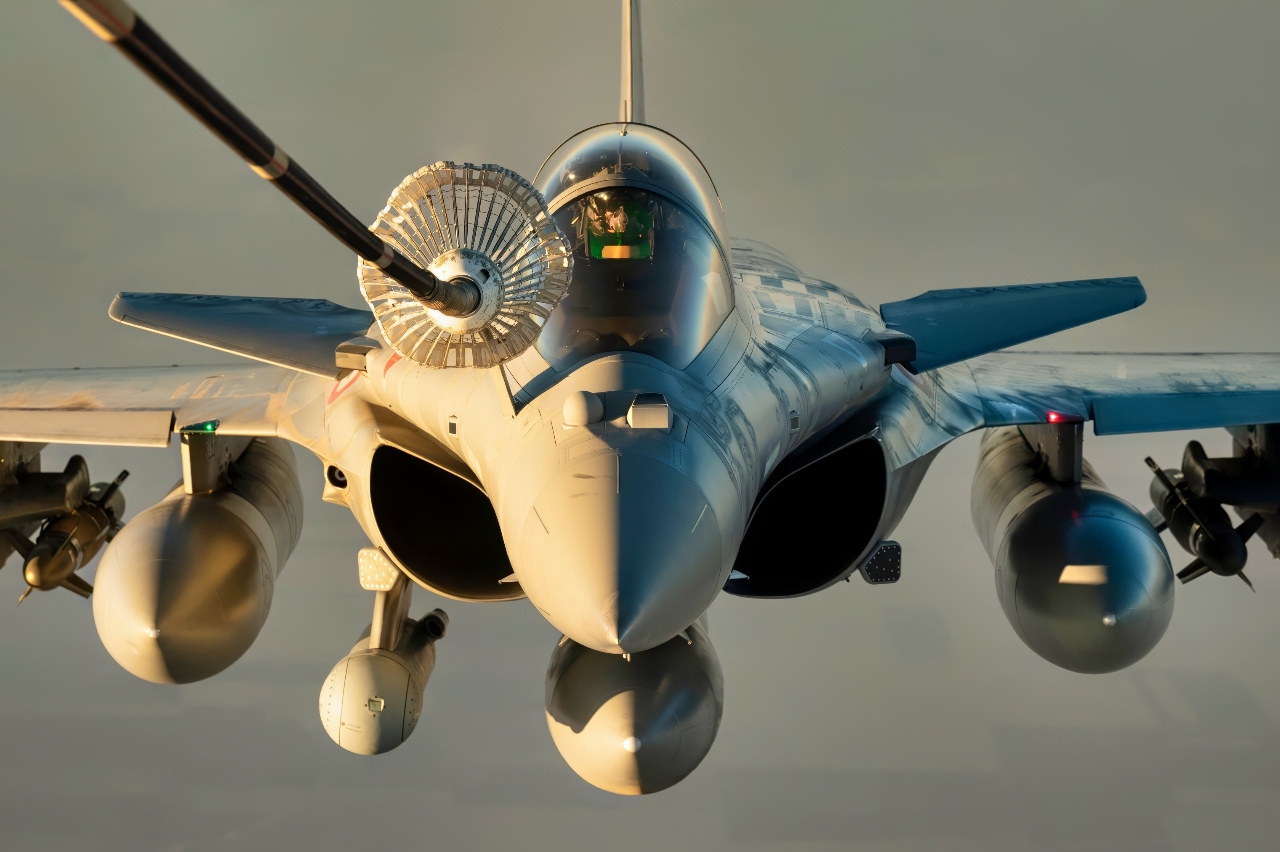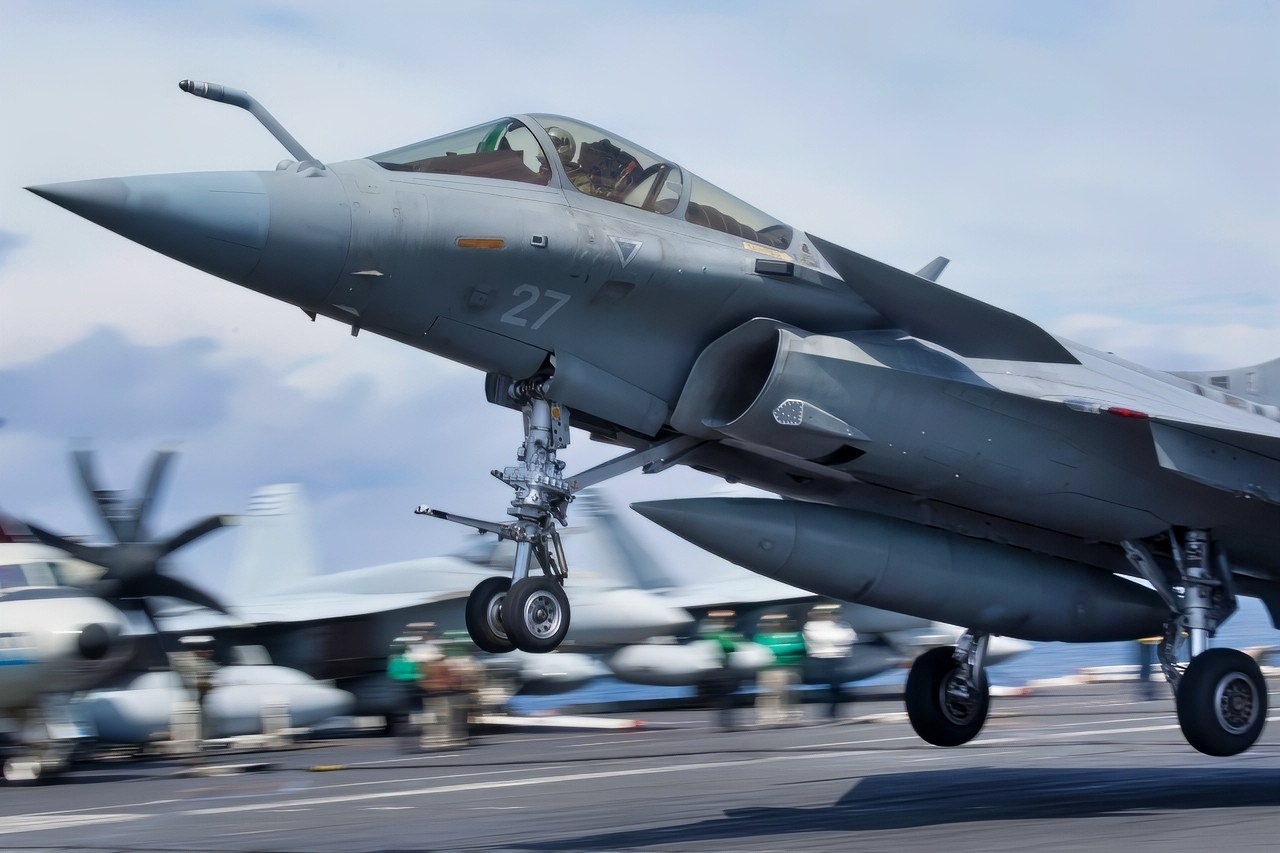Key Points and Summary – France’s Rafale F5 (“Super Rafale”) extends a proven 4+ gen airframe with next-gen sensors, connectivity, and loyal-wingman teaming.
-A new RBE-2XG radar aims to spot low-observable targets at long range, while upgraded EW, datalinks, Meteor, and expanded SEAD/strike kits push capability without the cost and sustainment burdens of full stealth.

A French Rafale fighter aircraft prepares to receive fuel from a U.S. Air Force KC-10 Extender assigned to the 908th Expeditionary Air Refueling Squadron, during a partner nation aerial refueling mission in the U.S. Central Command area of responsibility, Feb. 20, 2023. The KC-10 provides U.S. and partner nation aircraft the ability to remain in the air for longer durations, maximizing their patrol time and ensuring regional stability. (U.S. Air Force photo by Tech. Sgt. Daniel Asselta)

(July 3, 2018) A French Dassault Rafale M Fighter touches down on the flight deck aboard the Nimitz-class aircraft carrier USS Harry S. Truman (CVN 75). Harry S. Truman is currently deployed as part of an ongoing rotation of U.S. forces supporting maritime security operations in international waters around the globe. (U.S. Navy photo by Mass Communication Specialist 3rd Class Rebekah A. Watkins/Released)
-Lacking internal bays and all-aspect LO, Rafale remains more vulnerable in dense IADS—but survivability rises via standoff weapons, jamming, and networked cueing.
-Strategically, F5 preserves French autonomy and export momentum as SCAF/NGF matures, keeping forces credible through the 2030s even as “stealth isn’t everything” becomes a deliberate design bet.
R5 Dassault Rafale: Can It Win in the Stealth Era?
France’s flagship multirole fighter, the Dassault Rafale, is all set for a major upgrade, with an upgraded variant dubbed the “Super Rafale” or F5 standard just around the corner.
The new evolution of France’s top fighter promises improved sensors, weapons, and connectivity. But amid growing global competition among true stealth fighters, it’s curious that this fourth-generation airframe still won’t feature stealth technology.
The question now is whether this aging airframe can truly stay relevant without full stealth capabilities.
As Paris prepares to keep the Dassault Rafale combat-ready well into the 2030s and beyond, the program may offer a look at France’s mindset and plans for the future.
Meet the Rafale
Dassault Aviation developed the Rafale fighter to provide France with an “omni-role” fighter capable of air-superiority, ground-attack, reconnaissance, and even nuclear-deterrence missions.
It entered production in the late 1990s and early 2000s and has since seen combat in Libya, Mali, Syria, and Iraq. It has even been an export success, with models shipped to India, Qatar, Egypt, and elsewhere.

Dassault Rafale Fighter in India. Image Credit: Creative Commons.

A French Dassault Rafale receives fuel from a KC-10 near Iraq, Oct. 26, 2016. The Dassault Rafale is a twin-engine, multi-role fighter equipped with diverse weapons to ensure its success as a omnirole aircraft. The Rafale has flown in combat missions in several countries including Afghanistan, Libya, Syria and now it’s supporting the liberation of Mosul in Iraq. (U.S. Air Force photo by Senior Airman Tyler Woodward)
But rather than leaping ahead to a clean fifth-generation design sooner, France has followed an incremental upgrade path with the platform, from Rafale F3 to F4 and now towards F5. The intent? To extend the aircraft’s service life, maintain familiarity within its crews, and preserve its export viability. In short: “if it’s not broken, don’t fix it.”
Under the F5 or “Super Rafale” moniker, the aircraft is expected to integrate a new generation of avionics, sensors, and connectivity.
For example, the upcoming RBE-2XG radar is intended to detect low-observable targets at greater range. The goal? To detect a stealth fighter jet – rather than being stealthy itself – at a distance of more than 200 kilometers.
If the Rafale can pull that off, it can detect a Chinese J-20 or a Russian Su-57 from a great distance, serving as a warning platform while also being equipped to fight.
Crucially for this older platform, it will also incorporate “loyal wingman” drone teaming, giving it necessary backup during conflicts, as well as advanced data links and improved electronic warfare suites.
In terms of weapon capacity, the F5 is expected to incorporate Meteor missiles, next-generation air-to-ground munitions, and enhanced suppression of enemy air defenses.
The F5 is intended to bridge the gap until its next-generation fighter – under the SCAF/NGF program – officially enters service, keeping French air power viable through the 2030s and 2040s.
Stealth: the Missing Piece
Despite the upgrades, the Rafale will remain a 4+ generation fighter, not a true stealth platform. The Rafale, after all, was not designed for full-aspect low observability.
Instead, it was designed to have a reduced radar cross-section (RCS) and infrared signature, making it harder to detect—but it was never intended to be complete stealth.
The airframe lacks the shaping, internal weapons bays, and full radar-absorbent materials that define fifth-generation aircraft.
But while the Rafale is not truly stealthy, it is more than capable and offers the benefits of cost-effectiveness and flexibility.
Not only is the lack of stealth cheaper to implement, but it’s also a tested and popular platform that has already been developed, and it doesn’t have the same high maintenance demands as true stealth aircraft.
In an environment saturated with advanced radar and long-range SAMS, the Rafale is technically vulnerable – but there are ways it can survive. When coupled with electronic warfare, standoff weapons, and networked sensors, the aircraft can still prove capable in combat. That’s especially true with experienced pilots and crews.
From a strategic perspective, the Super Rafale is a hugely important asset for France and its export customers. It provides all forces that operate on it a path to capability growth without the need for a large budget, ongoing maintenance, or new logistics.
A complete stealth program includes all of those things and more.
France is also retaining its independence over its design and supply chain, avoiding reliance on U.S. restrictions – something that is becoming increasingly important, particularly for European customers.
The Dassault Rafale may not be all that stealthy, but it is doubling down on autonomy, new technologies, and versatility.
France is proving that even older platforms can remain relevant—and that stealth alone does not define an airframe’s success.
About the Author:
Jack Buckby is a British author, counter-extremism researcher, and journalist based in New York. Reporting on the U.K., Europe, and the U.S., he works to analyze and understand left-wing and right-wing radicalization, and reports on Western governments’ approaches to the pressing issues of today. His books and research papers explore these themes and propose pragmatic solutions to our increasingly polarized society. His latest book is The Truth Teller: RFK Jr. and the Case for a Post-Partisan Presidency.
More Military
‘Skipper, We Have Been Hit’: Tiny Nuclear Sub ‘Sank’ $4.5 Billion U.S. Navy Aircraft Carrier
China’s Military ‘Quantum Leap’ Doesn’t Add Up
Russia’s Air Defenses Are Springing Leaks—and Ukraine Is Exploiting Them
Japan Might Be Ready to Fight for Taiwan. Would America Do the Same?










